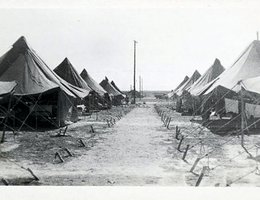
Nebraska’s geography was responsible for one of the major economic and social developments of the war. From border to border, the Army built a dozen air bases — far from the coasts. Ainsworth, Alliance, Bruning, Fairmont, Fort Crook, Grand Island, Harvard, Kearney, Lincoln, McCook, Scottsbluff, and Scribner all got air bases or satellite airfields during World War II.

"It is truly an amazing sight to see these Army air bases suddenly rise into view from farms, cattle ranges, or hayflats. As one drives across the state, there first appears an orange and black checkerboard water tank rising above the horizon. Then the blue-green glass windows of a control tower come into sight. Hangars housing big war birds are seen, their arched domes across the sky."
— Lt. Howard J. Otis, Air Force Public Relations Officer, July 1943.
With all of the air activity in the state, there were bound to be accidents. Many planes crashed on training flights. Fort McPherson National Cemetery near North Platte has several common graves with single headstones paying homage to airmen killed in crashes on Nebraska soil.
"Another vivid memory I have is of watching a plane, a B-17, in the sky one August day in 1943 and seeing it nose dive to the earth and burst into flame. The plane crash was near Wood River, Nebraska. All eight men aboard were killed."
— Rosalie Frazell Lippincott, Shelton teacher.

"I can remember the B-29s were a particular fascination to me because they were in Grand Island. . . . During school hours, if a plane went over, the whole school was dismissed for a few minutes to go out and watch the plane go over."
— Geraldine George Sorensen, Grand Island grade school student.
The roar of aircraft engines and the thousands of soldiers and civilian workers were constant reminders that the job of defeating the enemy on faraway battlefields began at home.